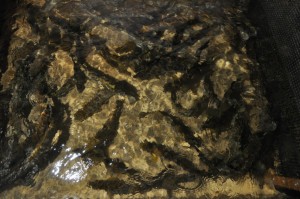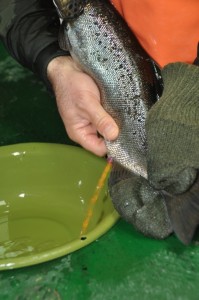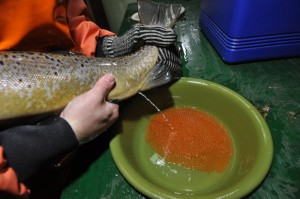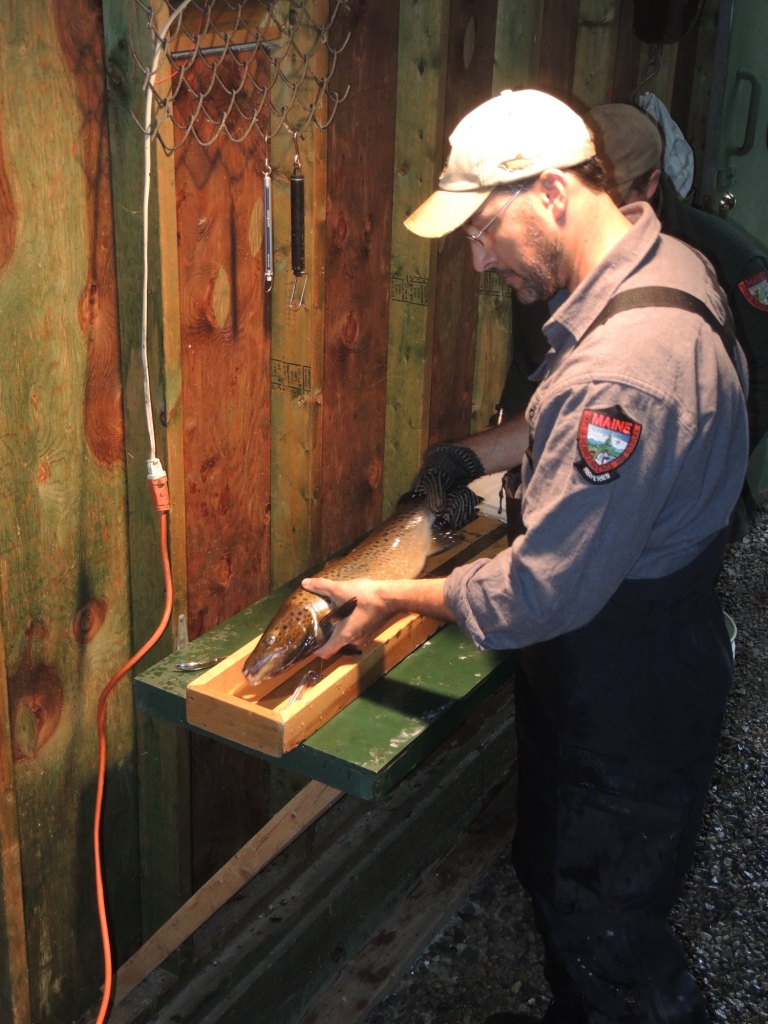November 17, 2014 at 4:39 pm
[caption id="attachment_138" align="alignright" width="300"] Salmon congregate in the raceways after traveling up the Jordan River[/caption]
The sheltered, concrete raceway may not be the pristine, pebbled waters that salmon normally seek to spawn, but to Maine’s landlocked salmon anglers, this journey up the Jordan River is vitally important to the health of Maine’s landlocked salmon fishery.
For it is here that IFW fish culturists will “strip” the salmon of their eggs and milt, and utilize the fertilized salmon eggs to bolster the salmon population throughout the lower half of the state.
Landlocked salmon are native to Maine, but originally, they were only found in four watersheds in the state: the St. Croix which includes Grand Lake Stream in Washington County, the Union River including Green Lake in Hancock County, the Penobscot which includes Sebec Lake in Piscataquis County, and of course, the Presumpscot, including Sebago Lake in Cumberland County.
Landlocked salmon are the same species, salmo salar, as Atlantic salmon. As many of you know, the urge to spawn in these fish is extremely strong, and they will go to great lengths to do so.
[caption id="attachment_141" align="alignright" width="199"]
Salmon congregate in the raceways after traveling up the Jordan River[/caption]
The sheltered, concrete raceway may not be the pristine, pebbled waters that salmon normally seek to spawn, but to Maine’s landlocked salmon anglers, this journey up the Jordan River is vitally important to the health of Maine’s landlocked salmon fishery.
For it is here that IFW fish culturists will “strip” the salmon of their eggs and milt, and utilize the fertilized salmon eggs to bolster the salmon population throughout the lower half of the state.
Landlocked salmon are native to Maine, but originally, they were only found in four watersheds in the state: the St. Croix which includes Grand Lake Stream in Washington County, the Union River including Green Lake in Hancock County, the Penobscot which includes Sebec Lake in Piscataquis County, and of course, the Presumpscot, including Sebago Lake in Cumberland County.
Landlocked salmon are the same species, salmo salar, as Atlantic salmon. As many of you know, the urge to spawn in these fish is extremely strong, and they will go to great lengths to do so.
[caption id="attachment_141" align="alignright" width="199"] Female salmon are stripped of their eggs by applying pressure in their abdomen area.[/caption]
However, in most lakes and ponds in Maine, there isn’t suitable spawning habitat to sustain these fisheries. While the department works to secure and protect habitat, factors such as dams and water quality issues linked to erosion, pollutants and sedimentation limit the amount of spawning habitat available to sustain many coldwater fisheries throughout the state.
That’s why each year in November, a crew of Inland Fisheries and Wildlife personnel gather along the banks of the Jordan River in Raymond to assist these salmon in spawning.
Like so many other salmon that migrate their way upriver, these landlocked salmon are blocked by a dam. However, an installed fishway leads the salmon to the concrete pens, where they stay until the salmon are “ripe” for spawning.
Once “ripe”, a team of state fish culturists assist these salmon in the spawning.
The salmon are first anesthetized, so they can be handled easily. Then, a female salmon is
“stripped” of her eggs by massaging and manipulating the fish’s belly, dropping her golden orange eggs into a large plastic bowl. A male salmon is “stripped” of its bright, white milt into the same bowl. The salmon are weighed and measured by fisheries biologists before they are released back into the river.
The eggs and milt are mixed thoroughly in hopes of fertilizing all the eggs, and then a portion of the eggs are scooped out and separated from the rest. Culturists take only a portion of the pair’s fertilized eggs, then take a portion of the next pair’s, and so and so on in order to maintain as wide a genetic diversity as possible. The extra eggs are saved as a precaution as well.
Female salmon are stripped of their eggs by applying pressure in their abdomen area.[/caption]
However, in most lakes and ponds in Maine, there isn’t suitable spawning habitat to sustain these fisheries. While the department works to secure and protect habitat, factors such as dams and water quality issues linked to erosion, pollutants and sedimentation limit the amount of spawning habitat available to sustain many coldwater fisheries throughout the state.
That’s why each year in November, a crew of Inland Fisheries and Wildlife personnel gather along the banks of the Jordan River in Raymond to assist these salmon in spawning.
Like so many other salmon that migrate their way upriver, these landlocked salmon are blocked by a dam. However, an installed fishway leads the salmon to the concrete pens, where they stay until the salmon are “ripe” for spawning.
Once “ripe”, a team of state fish culturists assist these salmon in the spawning.
The salmon are first anesthetized, so they can be handled easily. Then, a female salmon is
“stripped” of her eggs by massaging and manipulating the fish’s belly, dropping her golden orange eggs into a large plastic bowl. A male salmon is “stripped” of its bright, white milt into the same bowl. The salmon are weighed and measured by fisheries biologists before they are released back into the river.
The eggs and milt are mixed thoroughly in hopes of fertilizing all the eggs, and then a portion of the eggs are scooped out and separated from the rest. Culturists take only a portion of the pair’s fertilized eggs, then take a portion of the next pair’s, and so and so on in order to maintain as wide a genetic diversity as possible. The extra eggs are saved as a precaution as well. In some years, over 100 salmon will be stripped. This year’s count so far is in the 70s. Samples from each batch will be examined by the state’s fish pathologist in order to inspect them for diseases.
Once these fertilized eggs get to the hatchery, they are placed in egg trays, where the eggs will hatch out into fry later this winter. As they grow, they will be moved to larger tanks at the Casco Hatchery before they are released into the wild, starting at about 18 months from the time the adults spawned.
In the end, those migrating salmon that travelled but two miles from the depths of Sebago Lake will have offspring that will populate waterways throughout the lower half of the state.
[caption id="attachment_140" align="alignright" width="917"]
In some years, over 100 salmon will be stripped. This year’s count so far is in the 70s. Samples from each batch will be examined by the state’s fish pathologist in order to inspect them for diseases.
Once these fertilized eggs get to the hatchery, they are placed in egg trays, where the eggs will hatch out into fry later this winter. As they grow, they will be moved to larger tanks at the Casco Hatchery before they are released into the wild, starting at about 18 months from the time the adults spawned.
In the end, those migrating salmon that travelled but two miles from the depths of Sebago Lake will have offspring that will populate waterways throughout the lower half of the state.
[caption id="attachment_140" align="alignright" width="917"] Fisheries Biologist Jim Pellerin measures and weighs each salmon before releasing them. The data gives biologists a glimpse into the health of the salmon population.[/caption]
Fisheries Biologist Jim Pellerin measures and weighs each salmon before releasing them. The data gives biologists a glimpse into the health of the salmon population.[/caption]
 Salmon congregate in the raceways after traveling up the Jordan River[/caption]
The sheltered, concrete raceway may not be the pristine, pebbled waters that salmon normally seek to spawn, but to Maine’s landlocked salmon anglers, this journey up the Jordan River is vitally important to the health of Maine’s landlocked salmon fishery.
For it is here that IFW fish culturists will “strip” the salmon of their eggs and milt, and utilize the fertilized salmon eggs to bolster the salmon population throughout the lower half of the state.
Landlocked salmon are native to Maine, but originally, they were only found in four watersheds in the state: the St. Croix which includes Grand Lake Stream in Washington County, the Union River including Green Lake in Hancock County, the Penobscot which includes Sebec Lake in Piscataquis County, and of course, the Presumpscot, including Sebago Lake in Cumberland County.
Landlocked salmon are the same species, salmo salar, as Atlantic salmon. As many of you know, the urge to spawn in these fish is extremely strong, and they will go to great lengths to do so.
[caption id="attachment_141" align="alignright" width="199"]
Salmon congregate in the raceways after traveling up the Jordan River[/caption]
The sheltered, concrete raceway may not be the pristine, pebbled waters that salmon normally seek to spawn, but to Maine’s landlocked salmon anglers, this journey up the Jordan River is vitally important to the health of Maine’s landlocked salmon fishery.
For it is here that IFW fish culturists will “strip” the salmon of their eggs and milt, and utilize the fertilized salmon eggs to bolster the salmon population throughout the lower half of the state.
Landlocked salmon are native to Maine, but originally, they were only found in four watersheds in the state: the St. Croix which includes Grand Lake Stream in Washington County, the Union River including Green Lake in Hancock County, the Penobscot which includes Sebec Lake in Piscataquis County, and of course, the Presumpscot, including Sebago Lake in Cumberland County.
Landlocked salmon are the same species, salmo salar, as Atlantic salmon. As many of you know, the urge to spawn in these fish is extremely strong, and they will go to great lengths to do so.
[caption id="attachment_141" align="alignright" width="199"] Female salmon are stripped of their eggs by applying pressure in their abdomen area.[/caption]
However, in most lakes and ponds in Maine, there isn’t suitable spawning habitat to sustain these fisheries. While the department works to secure and protect habitat, factors such as dams and water quality issues linked to erosion, pollutants and sedimentation limit the amount of spawning habitat available to sustain many coldwater fisheries throughout the state.
That’s why each year in November, a crew of Inland Fisheries and Wildlife personnel gather along the banks of the Jordan River in Raymond to assist these salmon in spawning.
Like so many other salmon that migrate their way upriver, these landlocked salmon are blocked by a dam. However, an installed fishway leads the salmon to the concrete pens, where they stay until the salmon are “ripe” for spawning.
Once “ripe”, a team of state fish culturists assist these salmon in the spawning.
The salmon are first anesthetized, so they can be handled easily. Then, a female salmon is
“stripped” of her eggs by massaging and manipulating the fish’s belly, dropping her golden orange eggs into a large plastic bowl. A male salmon is “stripped” of its bright, white milt into the same bowl. The salmon are weighed and measured by fisheries biologists before they are released back into the river.
The eggs and milt are mixed thoroughly in hopes of fertilizing all the eggs, and then a portion of the eggs are scooped out and separated from the rest. Culturists take only a portion of the pair’s fertilized eggs, then take a portion of the next pair’s, and so and so on in order to maintain as wide a genetic diversity as possible. The extra eggs are saved as a precaution as well.
Female salmon are stripped of their eggs by applying pressure in their abdomen area.[/caption]
However, in most lakes and ponds in Maine, there isn’t suitable spawning habitat to sustain these fisheries. While the department works to secure and protect habitat, factors such as dams and water quality issues linked to erosion, pollutants and sedimentation limit the amount of spawning habitat available to sustain many coldwater fisheries throughout the state.
That’s why each year in November, a crew of Inland Fisheries and Wildlife personnel gather along the banks of the Jordan River in Raymond to assist these salmon in spawning.
Like so many other salmon that migrate their way upriver, these landlocked salmon are blocked by a dam. However, an installed fishway leads the salmon to the concrete pens, where they stay until the salmon are “ripe” for spawning.
Once “ripe”, a team of state fish culturists assist these salmon in the spawning.
The salmon are first anesthetized, so they can be handled easily. Then, a female salmon is
“stripped” of her eggs by massaging and manipulating the fish’s belly, dropping her golden orange eggs into a large plastic bowl. A male salmon is “stripped” of its bright, white milt into the same bowl. The salmon are weighed and measured by fisheries biologists before they are released back into the river.
The eggs and milt are mixed thoroughly in hopes of fertilizing all the eggs, and then a portion of the eggs are scooped out and separated from the rest. Culturists take only a portion of the pair’s fertilized eggs, then take a portion of the next pair’s, and so and so on in order to maintain as wide a genetic diversity as possible. The extra eggs are saved as a precaution as well. In some years, over 100 salmon will be stripped. This year’s count so far is in the 70s. Samples from each batch will be examined by the state’s fish pathologist in order to inspect them for diseases.
Once these fertilized eggs get to the hatchery, they are placed in egg trays, where the eggs will hatch out into fry later this winter. As they grow, they will be moved to larger tanks at the Casco Hatchery before they are released into the wild, starting at about 18 months from the time the adults spawned.
In the end, those migrating salmon that travelled but two miles from the depths of Sebago Lake will have offspring that will populate waterways throughout the lower half of the state.
[caption id="attachment_140" align="alignright" width="917"]
In some years, over 100 salmon will be stripped. This year’s count so far is in the 70s. Samples from each batch will be examined by the state’s fish pathologist in order to inspect them for diseases.
Once these fertilized eggs get to the hatchery, they are placed in egg trays, where the eggs will hatch out into fry later this winter. As they grow, they will be moved to larger tanks at the Casco Hatchery before they are released into the wild, starting at about 18 months from the time the adults spawned.
In the end, those migrating salmon that travelled but two miles from the depths of Sebago Lake will have offspring that will populate waterways throughout the lower half of the state.
[caption id="attachment_140" align="alignright" width="917"] Fisheries Biologist Jim Pellerin measures and weighs each salmon before releasing them. The data gives biologists a glimpse into the health of the salmon population.[/caption]
Fisheries Biologist Jim Pellerin measures and weighs each salmon before releasing them. The data gives biologists a glimpse into the health of the salmon population.[/caption]Categories